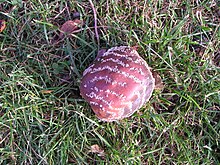
Fire blight, also written fireblight, is a contagious disease affecting apples, pears, and some other members of the family Rosaceae. It is a serious concern to apple and pear producers. Under optimal conditions, it can destroy an entire orchard in a single growing season.

Peach leaf curl is a plant disease characterized by distortion and coloration of leaves and is caused by the fungus Taphrina deformans, which infects peach, nectarine, and almond trees. T. deformans is found in the United States, Europe, Asia, Africa, Australia, and New Zealand. Peach leaf curl reduces the amount of leaves and fruit produced by peach and nectarine trees.

Grape black rot is a fungal disease caused by an ascomycetous fungus, Guignardia bidwellii, that attacks grape vines during hot and humid weather. “Grape black rot originated in eastern North America, but now occurs in portions of Europe, South America, and Asia. It can cause complete crop loss in warm, humid climates, but is virtually unknown in regions with arid summers.” The name comes from the black fringe that borders growing brown patches on the leaves. The disease also attacks other parts of the plant, “all green parts of the vine: the shoots, leaf and fruit stems, tendrils, and fruit. The most damaging effect is to the fruit”.

Diplodia tip blight, also known as Sphaeropsis blight, is a widespread disease affecting conifers caused by an opportunistic fungal pathogen, Diplodia sapinea. It is found in “both hemispheres between the latitudes 30° and 50° north and south". The diseases symptoms include: damping off and collar rot of seedlings, stem canker, root disease, and, most commonly, shoot blight. These symptoms have caused significant economic loss to nurseries and pine plantations. In a nursery in the north-central United States, losses of 35% have been reported. Shoot blight and eventual die back can cause a reduction of marketable volume in timber by 63%. Infection of terminal shoots can result in dead-top which significantly limits the usable length of the tree trunk. The presence of the pathogen in concert with severe weather conditions can lead to extreme loss. Following a severe hailstorm in South Africa, nearly 5,000 acres of pine plantation were infected with Diplodia tip blight. It was necessary to prematurely harvest large swaths of the plantations resulting in a loss of 45%. Areas that were not harvested prematurely still suffered an average timber loss of 11%.
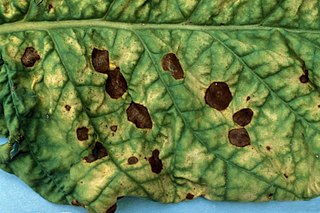
Alternaria alternata is a fungus causing leaf spots, rots, and blights on many plant parts, and other diseases. It is an opportunistic pathogen on over 380 host species of plant.
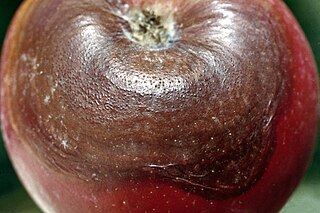
Botryosphaeria obtusa is a plant pathogen that causes frogeye leaf spot, black rot and cankers on many plant species. On the leaf it is referred to as frogeye leaf spot; this phase typically affects tree and shrubs. In fruit such as the apple, cranberry and quince, it is referred to as black rot, and in twigs and trunks it causes cankers.
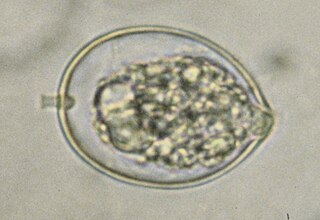
Phytophthora cactorum is a fungal-like plant pathogen belonging to the Oomycota phylum. It is the causal agent of root rot on rhododendron and many other species, as well as leather rot of strawberries.

Monilinia laxa is a plant pathogen that is the causal agent of brown rot of stone fruits.
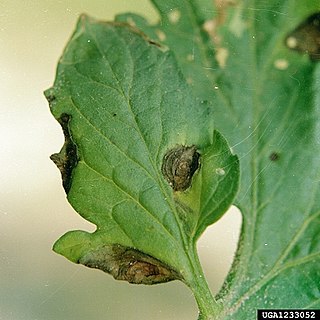
Alternaria solani is a fungal pathogen that produces a disease in tomato and potato plants called early blight. The pathogen produces distinctive "bullseye" patterned leaf spots and can also cause stem lesions and fruit rot on tomato and tuber blight on potato. Despite the name "early," foliar symptoms usually occur on older leaves. If uncontrolled, early blight can cause significant yield reductions. Primary methods of controlling this disease include preventing long periods of wetness on leaf surfaces and applying fungicides. Early blight can also be caused by Alternaria tomatophila, which is more virulent on stems and leaves of tomato plants than Alternaria solani.
Phytophthora megakarya is an oomycete plant pathogen that causes black pod disease in cocoa trees in west and central Africa. This pathogen can cause detrimental loss of yield in the economically important cocoa industry, worth approximately $70 billion annually. It can damage any part of the tree, causing total yield losses which can easily reach 20-25%. A mixture of chemical and cultural controls, as well as choosing resistant plant varieties, are often necessary to control this pathogen.

Anisogramma anomala is a plant pathogen that causes a disease known as Eastern filbert blight on Corylus spp. (hazlenut). Also known as EFB.

Rhabdocline pseudotsugae is a fungal plant pathogen. The pathogen, along with Rhabdocline weirii causes Rhabdocline needlecast; R. weirii only affects Douglas-fir trees. The disease causes the needles of the tree to discolor and eventually fall from the tree. It was originally common to the Rocky Mountain states of the United States but has since spread to Europe. Infections usually start in the spring or early summer and can change the color of the foliage to a variety of hues. The fungus produces apothecia that are normally found on the underside of needles but they also occur on the topside as well.
Monilinia fructigena is a plant pathogen in the fungus kingdom causing a fruit rot of apples, pears, plums, peaches and cherries.
This article summarizes different crops, what common fungal problems they have, and how fungicide should be used in order to mitigate damage and crop loss. This page also covers how specific fungal infections affect crops present in the United States.

Monilinia oxycocci (Woronin) Honey,, common names cranberry cottonball, cranberry hard rot, tip blight, is a fungal infection of large cranberry and small cranberry. The tips of young flowering shoots wilt before they flower. Fruit that forms on the plant can then be infected by the asexual spores traveling through the plant, causing the berries to harden, turn cottony on the inside, and dry out instead of maturing. The berries are filled with a cotton-like fungus and are generally yellowish with tan stripes or blotches at maturity, making them unmarketable. It results in important economic impacts on many cranberry marshes, particularly in Wisconsin.

Armillaria root rot is a fungal root rot caused by several different members of the genus Armillaria. The symptoms are variable depending on the host infected, ranging from stunted leaves to chlorotic needles and dieback of twigs and branches. However, all infected hosts display symptoms characteristic of being infected by a white rotting fungus. The most effective ways of management focus on limiting the spread of the fungus, planting resistant species, and removing infected material. This disease poses a threat to the lumber industry as well as affecting recreational areas.
Septoria musiva, correct taxonomic name: Sphaerulina musiva, is an ascomycete fungus responsible of a leaf spot and canker disease on poplar trees. It is native on the eastern cottonwood poplar Populus deltoides, causing only a leaf spot symptom. On susceptible hybrid poplars, S. musiva causes necrotic lesions on the leaves which lead to premature defoliation, and cankers on the stem and branches which can reduce growth, predispose the tree to colonisation by secondary organisms, and cause stem breakage.

Phomopsisblight of juniper is a foliar disease discovered in 1917 caused by the fungal pathogen Phomopsis juniperovora. The fungus infects new growth of juniper trees or shrubs, i.e. the seedlings or young shoots of mature trees. Infection begins with the germination of asexual conidia, borne from pycnidia, on susceptible tissue, the mycelia gradually move inwards down the branch, and into the main stem. Management strategies mainly include removing and destroying diseased tissue and limiting the presence of moisture on plants. Junipers become resistant to infection as they mature and the young yellow shoots turn dark green. Preventive strategies include planting only resistant varieties and spraying new growth with fungicide until plants have matured.
Gummy stem blight is a cucurbit-rot disease caused by the fungal plant pathogen Didymella bryoniae. Gummy stem blight can affect a host at any stage of growth in its development and affects all parts of the host including leaves, stems and fruits. Symptoms generally consist of circular dark tan lesions that blight the leaf, water soaked leaves, stem cankers, and gummy brown ooze that exudes from cankers, giving it the name gummy stem blight. Gummy stem blight reduces yields of edible cucurbits by devastating the vines and leaves and rotting the fruits. There are various methods to control gummy stem blight, including use of treated seed, crop rotation, using preventative fungicides, eradication of diseased material, and deep plowing previous debris.
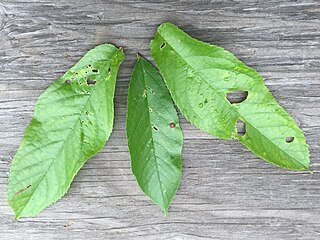
Shot hole disease is a serious fungal disease that creates BB-sized holes in leaves, rough areas on fruit, and concentric lesions on branches. The pathogen that causes shot hole disease is Wilsonomyces carpophilus.

